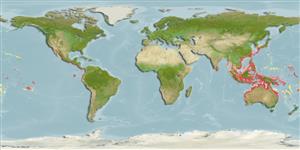Teleostei (teleosts) >
Gobiiformes (Gobies) >
Gobiidae (Gobies) > Gobiinae
Etymology: Valenciennea: From Achille Valenciennes 1794-1865; he worked with Duméril, Cuvier and Lacepède since 1815; malacologist, author of a "Histoire naturelle des poissons" (Ref. 45335).
Eponymy: Achille Valenciennes (1794–1865) was a French zoologist; primarily an ichthyologist and conchologist. [...] (Ref. 128868), visit book page.
Issue
Type locality: Sanya Yantian, Boan County, Guangdong Province, China.
Environment: milieu / climate zone / depth range / distribution range
Ecology
Marine; reef-associated; depth range 1 - 30 m (Ref. 48637), usually 2 - 30 m (Ref. 27115). Tropical; 22°C - 27°C (Ref. 27115)
Western Pacific: Taiwan, Macao, Hong Kong, Philippines, and from Western Australia to Sydney, New South Wales (Australia). Recently reported from Tonga (Ref. 53797).
Size / Weight / Age
Maturity: Lm ? range ? - ? cm
Max length : 13.0 cm TL male/unsexed; (Ref. 9710)
Dorsal spines (total): 6 - 7; Dorsal soft rays (total): 13 - 17; Anal spines: 1; Anal soft rays: 13 - 16. Characterized by yellowish white to pale mauve body color; blue-edged orange stripe on cheek extending along lower side to base of caudal fin; presence of pair of orange-brown stripes on back; caudal fin with dark margin and white submarginal band; juvenile has yellow stripe on midside and pair of dark stripes on back; rhomboid caudal fin; length of caudal fin 3.1-3.6 in SL; longitudinal scale series 63-92; ctenoid body scales, becoming cycloid anteriorly below first dorsal fin and on abdomen; head or midline of nape without scales; side of nape partly scaled with patch extending forward to above posterior edge of preopercle; partly or fully scaled pectoral-fin base in adult; usually scaled prepelvic area in adult; depth of body 5.5-6.3 in SL (Ref. 90102).
Occurs over fine, silty or muddy sand bottoms, Ref. 48637. Usually in pairs (Ref. 90102). Sifts large mouthfuls of sand to feed and dig its own burrow.
Life cycle and mating behavior
Maturity | Reproduction | Spawning | Eggs | Fecundity | Larvae
Hoese, D.F. and H.K. Larson, 1994. Revision of the Indo-Pacific gobiid fish genus Valenciennea, with descriptions of seven new species. Indo-Pac. Fish. (23):71 p. (Ref. 8527)
IUCN Red List Status (Ref. 130435: Version 2024-2)
Threat to humans
Harmless
Human uses
Fisheries: commercial; aquarium: commercial
Tools
Special reports
Download XML
Internet sources
Estimates based on models
Preferred temperature (Ref.
123201): 21.4 - 29, mean 27.7 °C (based on 1292 cells).
Phylogenetic diversity index (Ref.
82804): PD
50 = 0.5000 [Uniqueness, from 0.5 = low to 2.0 = high].
Bayesian length-weight: a=0.00724 (0.00339 - 0.01546), b=3.10 (2.92 - 3.28), in cm total length, based on LWR estimates for this (Sub)family-body shape (Ref.
93245).
Trophic level (Ref.
69278): 3.2 ±0.3 se; based on size and trophs of closest relatives
Resilience (Ref.
120179): High, minimum population doubling time less than 15 months (Preliminary K or Fecundity.).
Fishing Vulnerability (Ref.
59153): Low vulnerability (10 of 100).
Nutrients (Ref.
124155): Calcium = 116 [52, 214] mg/100g; Iron = 0.712 [0.369, 1.369] mg/100g; Protein = 17.9 [15.9, 19.6] %; Omega3 = 0.088 [0.039, 0.164] g/100g; Selenium = 26.4 [12.9, 56.5] μg/100g; VitaminA = 112 [29, 390] μg/100g; Zinc = 1.91 [1.25, 2.80] mg/100g (wet weight);
